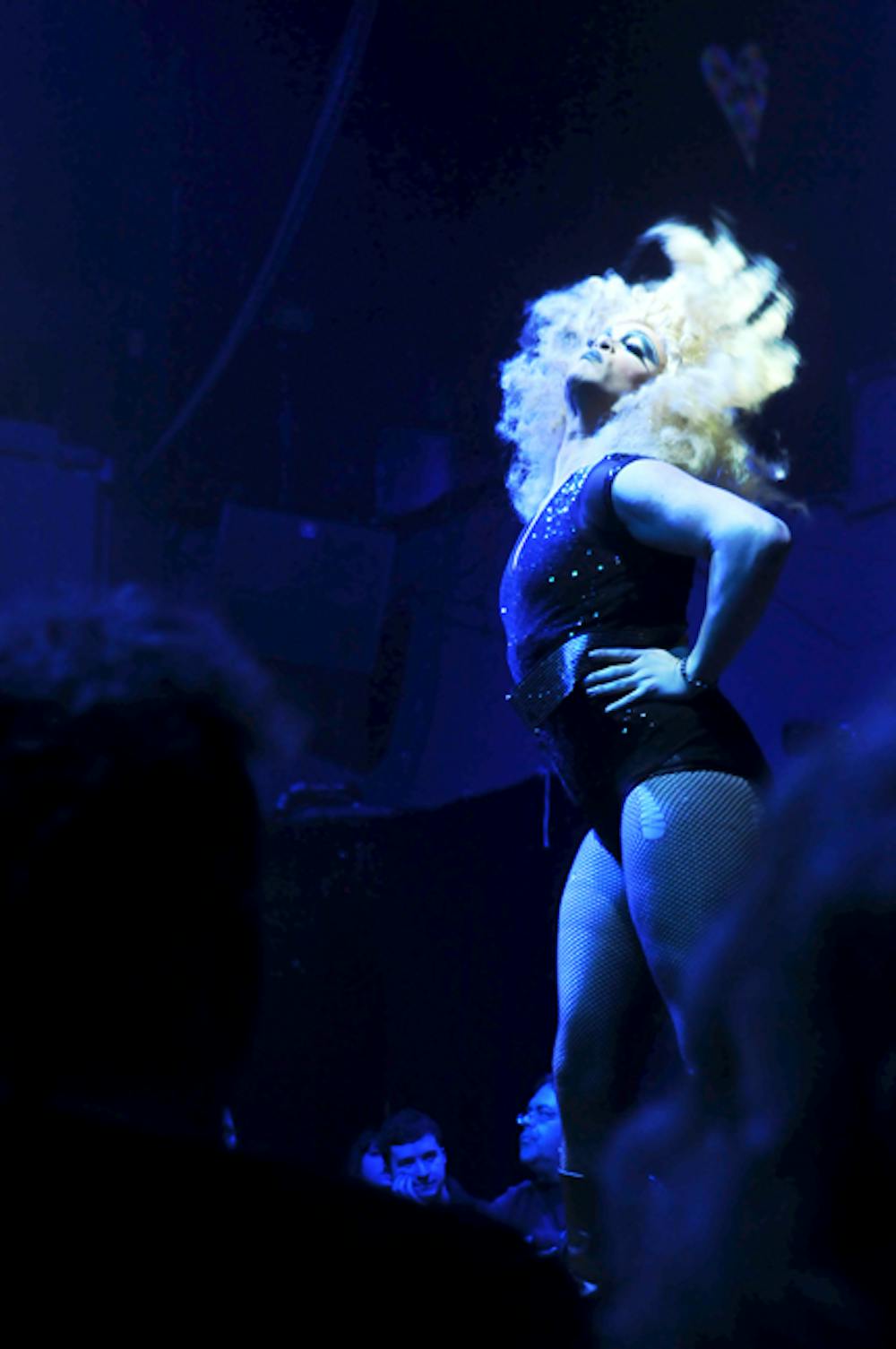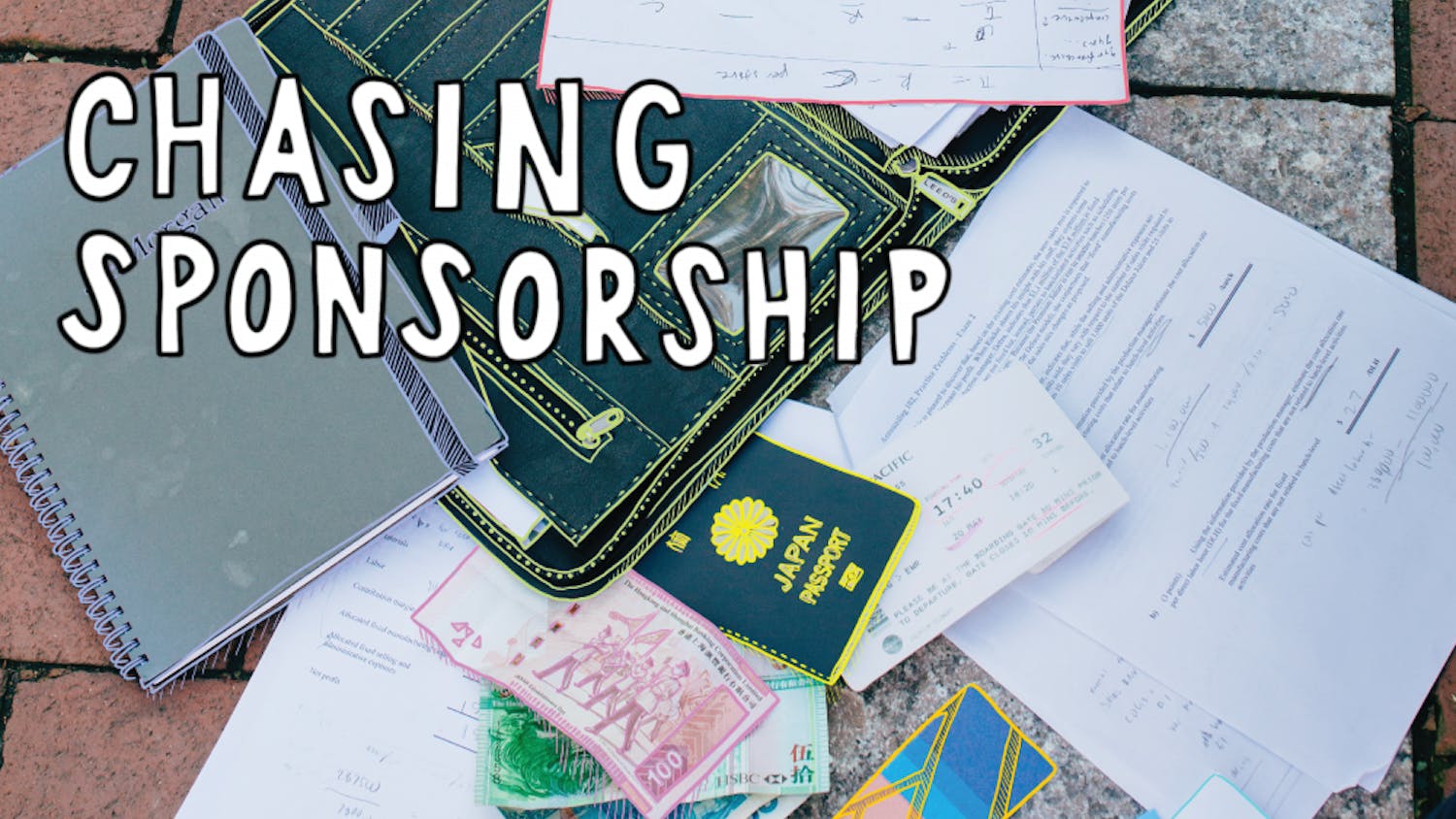“Oh my god, I have to tell you about the blowjob I got the other day,” drag queen Miss Karma tells me in her apartment as she lines my lips with red pencil. “He put a Listerine strip in his mouth. Whoa. It was intense.” I spend the next two hours getting plucked, brushed, lashed, teased and tucked by Miss Karma, or Brendan, as he’s known out of drag. Neither persona shies away from subjects that might make the uninitiated uncomfortable, as Brendan continues to tell me about Miss Karma’s sexy, Hot Topic Barbie doll image. After putting the final touches on my makeup, Brendan helps me slide into a slinky peach dress and pins an electric blue wig on my head. I get the first glimpse of myself in the mirror in full face and, damn, I look hot. It’s only that… I look unrecognizable. I am a completely different person, a clean slate. Caking layers upon layers of cosmetics on my face has washed away my identity. It’s both troubling and comforting. I can be anybody I want to be.
Brendan agrees. “When I get into drag, Karma does things that Brendan wouldn’t even dream of. As Brendan, I would never leave the house in even a tank top. As Karma, I’ll wear boobie tassels and fucking corsets and shit. It’s basically me getting to express my super feminine side.”
Perched on six–inch heels, Miss Karma joins drag queens Roxy Boom Boom and Saline at Voyeur Nightclub on 12th and Saint James Streets as the girls take the stage in the first round of this year’s Philly Drag Wars competition. The girls, dressed in complete nuns’ habits, begin to fall into choreography as the opening notes of Madonna’s “Material Girl” start to play. They bring the audience to its feet in a standing ovation after a mid–performance quick change into skimpier, more sequined outfits. It was the performance of the night, gaining them first place and a spot in the next round of the competition the following Tuesday.
“We entertain and we make you smile. We intrigue you. We break conventional social rules by putting on lipstick. But don’t let the glitter fool you; drag queens will wreck your shit if you cross the line,” Miss Karma responds after I ask the most basic question: Why? Why choose to dress up as a woman and subject yourself to more potential discrimination as a result? In short: it’s fun. I can’t disagree. It’s like adult dress–up; drag lets you live out a fantasy for a night.
Drag has been dancing on the fringes of gay culture since long before the rainbow–flag–toting, Pride–parade–marching gay of today. Films like “Paris Is Burning” (1990) and “The Adventures of Priscilla, Queen of the Desert,” (1994) shoved drag into the mainstream over the past two decades. And with the recent surge in popularity of “RuPaul’s Drag Race,” a reality series in which queens compete in drag challenges and are eliminated on a weekly basis, drag is quickly gaining recognition as a legitimate and meaningful undertaking, both inside and outside of the gay community.
Television’s way of saying, “we’re here, we’re queer, get used to it,” “RuPaul’s Drag Race” received heaps of praise from queens for sashaying drag into the hearts of modern pop culture lovers, but the show isn’t without its criticisms. “I feel like it’s almost a double–edged sword,” one queen waxes philosophically, “on one hand it brings drag to a whole new audience. However, it doesn’t paint an accurate picture of what we do. There’s a lot more to drag that isn’t shown.” Miss Karma isn’t afraid to put it more bluntly. “Drag Race is unbelievably fun, but it’s not a drag show. If you want to see a drag show you go to Voyeur and you fucking watch girls perform.”
Philly Drag Wars, a drag competition hosted by Mimi Imfurst, a former contestant on “RuPaul’s Drag Race,” is currently in its second cycle. The show does its best to highlight new and upcoming queens that may not have the name recognition to draw in large crowds yet. And due to the popularity of “Drag Race,” local competitions like Drag Wars have garnered something of a cult following.
Philadelphia Drag superstar Cleo Phatra, Queen of Denial, is lip–syncing to Lady Gaga’s “Bad Romance” at the Philly Drag Wars Winner–Takes–All Battle Royale. Dressed as a Victorian sex robot, Cleo reaches into her bosom and yanks out a fabricated robot heart, releasing the bag of fake blood stored in her bra. The sticky fluid flows over her voluptuous curves and soaks her tip money. “I was questioned by the transit police later that night for having a bag filled with blood–covered one dollar bills,” Cleo’s male counterpart, Bobby Fabulous, tells me afterwards. “Some girl reported me!”
Misinterpretations like this are common outside the community. In my mind, backlash and bigotry were too, but Cleo and her drag sister Luna LaVey beg to differ. “I’ve heard horror stories, but I’ve yet to experience any discrimination and for that I truly am happy,” Luna says. “I feel like drag has become less of a taboo and people are starting to appreciate what we do. Cleo and I had to walk down South Street at six o’clock on a Saturday in full drag and the only response we got was a whole lot of people wanting to take pictures with us.”
In fact, the queens all agreed that they receive more criticism from within the drag community than from outside it. Some girls have what it takes to perform and some don’t. According to the queens, the only way to improve is by being knocked down a few pegs. Throwing shade (the drag queen version of dishing sassy insults) is an essential technique for any truly great queen. There’s a steep learning curve in drag, and if you don’t bite back, you’ll be eaten alive.
“Oh yeah,” Brendan admitted, “I’ve received so much criticism. ‘You don’t dance, you’re not interesting enough, your music selection isn’t good.’ I know I ain’t got a thigh gap, but a lot of the girls expect a performer to act a certain way, so we critique. But in the end we all just want each other to be better for it.”
The unity that exists between the queens is instantly apparent even from an interloper’s perspective. All the criticizing, the cat fighting, the “reading,” is ultimately done out of love, not malice, Brendan says while putting my wig on. “The girls are really helpful. I lost my makeup bag and one of the girls offered to give me some of hers. It’s really hard when somebody not in the community critiques you because they don’t know what goes into this. It’s easier to take it from the girls because we’re really close.”
The queens support one another, making makeshift families of drag mothers, sisters and daughters. Much like frats, they create houses and lineages devoted to styles and types of drag. They stick together, because despite the progress made by drag queens in recent years, there’s always fear present in the minds of even the most self–assured queens. “You have to be really confident to walk out of your house in women’s clothing,” Miss Karma says.
I can empathize. In my few brief moments outside in drag, I received stares—mostly benevolent, but still disconcerting—from every person I passed on the street. “In Philly, it’s more about being yourself,” Brendan assures me. “It takes a lot of balls to be a girl.”
If anything, it became apparent that the drag community is one of the most accepting in Philadelphia. Every single person I contacted was willing and excited to speak to me. When I asked to be put in drag, all were fantastically accommodating. In a community made up of outsiders, I was instantly treated like an insider. It’s been said that drag queens have big hair and bigger hearts. In my experience, that is unquestionably true.
Almost a year ago exactly I watched as drag queen Dylayla Mizani centered herself with a few steady breaths before her performance at the Penn drag competition, hosted every year by the Queer Student Alliance. She launched full force into the “Single Ladies” choreography as Beyonce’s powerhouse vocals filled the room. Dylayla evoked an energy that coupled perfectly with the R&B female empowerment anthem. She tells me that she is effortlessly fishy, which apparently means she looks biologically female in drag. Her style is vastly different from Cleo Phatra or Miss Karma, who employ elaborate costumes and unique artistry.
Dressed in a simple black leotard, Dylayla engaged the crowd in a different way from her drag counterparts, just as every other queen has her own tricks to please the crowd. Luna LaVey conveys the fluidity of drag eloquently. “If I want to do a goofy performance and throw glitter out of a beer bottle all over the audience, I can. Or if I want to put on something skimpy and do a burlesque performance, I can. It’s one of the joys of drag. You make it what you want it to be.”
Some queens, like Miss Karma, view their drag as an art performance. Others do it for the fun, or the attention. All of them will entertain you. “As long as you’re having a good time, you’re doing it right.”
Party hopping around West Philadelphia, I spend a few hours in full drag. The reaction is overwhelmingly positive. I receive requests for pictures and hugs, multiple exaltations of “Ohmygod! Sweetie, you look fabulous!” I revel in the attention, until I don’t. One drunken frat guy gropes me and asks for a lap dance “from the T–girl.” I realize not all of the stares are given approvingly. I leave and walk back to my place, the heels and wig Brendan let me borrow in hand.
I scrub my face for ten minutes before I start to recognize myself in the mirror. My eyes burn from the rubbing and the eyelash glue refuses to wash away completely. The result looks like I'm still wearing mascara, but it’ll have to wait until tomorrow. “I’m not going to say that some of the people close to me didn’t have negative reactions when I started doing drag,” Miss Karma explains, “but I know that if you’re doing something, and it upsets someone, you’re probably doing it right. At the end of the day I go home, I take my clothes off, I untuck my dick and I melt my face off. That’s all there is to it.”
In a community that faces so much misunderstanding, it’s easy to get beaten down. But in the words of famed drag queen Latrice Royale, “it’s OK to fall down. Get up, look sickening and make them eat it.” Preach, sister.
-Zacchiaus McKee is a junior majoring in anthropology from Pittsburgh, Pennsylvania. He is Highbrow Editor for 34th Street.







